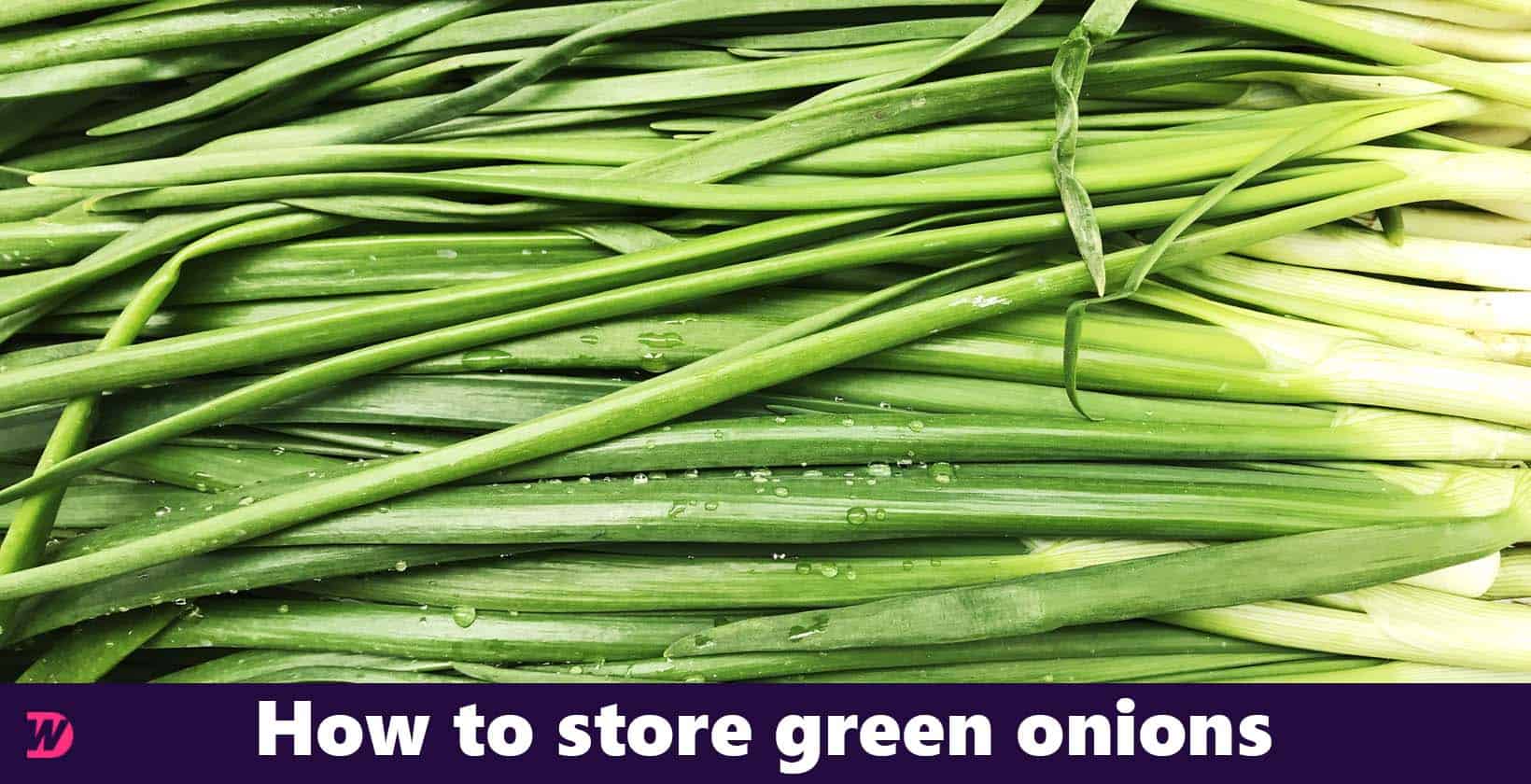Storing green onions can be done effectively with a few simple methods, such as using a damp paper towel, a jar of water, or freezing them in an airtight container. Proper storage helps in preserving green onions for a longer period, ensuring minimal waste, and maintaining their freshness and flavor for culinary use. One popular method involves wrapping the green onions in a slightly damp paper towel and placing them in a zip-top bag, which is then stored in the crisper drawer of the refrigerator. Alternatively, green onions can be stored in a jar with water, where the roots are submerged, and the jar is placed on a countertop or in the refrigerator. For longer-term storage, green onions can be washed, dried, chopped, and stored in an airtight container within the freezer. These methods ensure the green onions stay fresh and ready to use for a variety of dishes.
VIEW IN GALLERY
Understanding how to properly store green onions is an essential skill for home cooks and culinary enthusiasts alike. By following the recommended storage techniques, individuals can maximize the shelf-life and quality of these versatile and flavorful ingredients, making them readily accessible for cooking at any time.
Selecting High-Quality Green Onions
When shopping for green onions, it’s important to choose the freshest produce to ensure a longer shelf life and the best taste. The following tips will help you identify and select high-quality green onions.
First, examine the color of the green onions. The best ones should have bright green tops and white bulbs. Avoid those with yellow or wilted leaves, which can indicate they are past their prime.
Next, consider the size and texture. Good quality green onions should have firm and straight stalks, while the bulbs should be slender and not too large. If the green onions have soft or slimy spots, it’s best to avoid them as this can indicate spoilage or damage.
Finally, take a whiff of the green onions. A fresh and pleasant aroma is a good sign of their quality. Stay away from those with a particularly strong or unpleasant odor, as it can be an indication of spoilage or decay.
By following these guidelines, you’ll be able to select high-quality green onions that are ripe and ready to enjoy in your favorite dishes. Proper storage methods (such as using a bag or jar and a windowsill jar with water) will further ensure their freshness once you bring them home.
Preparing Green Onions for Storage
Proper preparation of green onions before storage is essential to maintain their freshness and extend their shelf life. This section provides information on how to trim and wash green onions correctly for optimal storage results.
Trimming
Start by removing any wilted, brown, or slimy leaves from the green onions. It is best to do this either using your hands or a pair of clean kitchen shears. Avoid cutting the entire onion, as the white bulb and root section are crucial for maintaining freshness during storage.
Next, trim the roots slightly, leaving a small portion of the root section intact. Be careful not to cut too much of the roots, as they help in absorbing water during storage and contribute to keeping the green onions fresh for longer periods.
Washing
Before storing green onions, it is important to wash them thoroughly to remove any dirt, debris, or lingering bacteria. Hold the green onions under cool, running water and gently rub each leaf to ensure all surfaces are clean. If the onions are particularly dirty or grown in sandy soil, you may need to rinse them more than once to ensure they are entirely clean.
After washing, gently shake off any excess water and pat the onions dry using a clean cloth or paper towel. It is essential to remove as much moisture as possible, as dampness can promote the growth of mold and reduce the freshness of green onions during storage.
Different Storage Methods
There are several ways to store green onions to prolong their freshness and maintain their flavor. This section will explore four popular storage methods: Refrigerator, Freezing, Drying, and Pickling.
Refrigerator
One easy method of preserving green onions is by storing them in the refrigerator. To do this, you can either wrap the green onions in a slightly damp paper towel and store them in a storage bag, or keep them in a glass or mason jar with about an inch of water.
Freezing
Another option is freezing green onions, which is great for long-term storage. To freeze them, simply chop the onions and place them in an airtight container or freezer bag. This method may result in a slight change in texture, but the flavor will remain intact.
Drying
Drying green onions is another method to preserve them. To do this, wash the onions thoroughly, cut off the root ends, and spread them out on a clean towel or paper towel to dry. Once completely dry, you can store the green onions in an airtight container in a cool, dark place. Note that dried green onions will have a slightly different flavor and texture than fresh ones.
Pickling
Pickling green onions can add a tangy and slightly sweet flavor to your dishes. To pickle green onions, prepare a pickling solution consisting of vinegar, water, sugar, and spices of your choice. Place the cleaned green onions into a jar and pour the pickling solution over them. Ensure they are completely submerged, and then seal the jar. Store the jar in a cool, dark place for a few weeks or refrigerate it for faster pickling.
Below is a table explaining the different storing methods for green onions.
| Method | Steps | Pros | Cons |
|---|---|---|---|
| Refrigerator | Wrap in damp paper towel and store in zip-top bag in the crisper drawer of the fridge OR place in a jar with water, where the roots are submerged, and store on a countertop or in the fridge | Easy to do, maintains freshness and flavor for a few weeks | Limited storage time, may not be suitable for long-term storage |
| Freezing | Wash, dry, chop, and store in an airtight container in the freezer | Great for long-term storage, maintains flavor | Results in a slight change in texture |
| Drying | Wash, cut off roots, and spread on a clean towel or paper towel to dry. Store in an airtight container in a cool, dark place | Good for long-term storage, dried green onions are versatile | Slightly different flavor and texture than fresh green onions |
| Pickling | Prepare a pickling solution consisting of vinegar, water, sugar, and spices. Place the cleaned green onions into a jar and pour the pickling solution over them. Ensure they are completely submerged, and then seal the jar. Store in a cool, dark place for a few weeks or refrigerate for faster pickling | Adds a tangy and slightly sweet flavor to dishes, can be stored for several months | Requires pickling supplies, time-consuming |
How to Store Green Onions (Guide)
Storing green onions properly can help extend their freshness and prevent them from wilting too soon. There are a few methods you can use to keep your green onions fresh for an extended period.
One effective way to store green onions is to keep them in a jar of water. Simply place the green onions with their root ends intact in a glass or mason jar, filled with about an inch of water. Be sure to keep water in the jar, and change it every couple of days to maintain freshness. This method allows the green onions to continue absorbing water and stay crisp.
Another method is to wrap the uncut green onions in a damp paper towel and place them in a plastic bag. Seal the bag and store it in the refrigerator. The paper towel helps maintain the moisture and humidity needed to keep the green onions fresh.
For a longer storage option, you can wrap the uncut green onions in aluminum foil and store them in the refrigerator. This method can keep the green onions fresh for up to a week.
Additionally, you can store green onions in the windowsill by keeping them in a jar of water. This method not only keeps the green onions fresh but can also promote growth and potentially extend their life.
Properly storing green onions can help ensure that they stay fresh, crisp, and flavorful for your next meal.
Maximizing Shelf Life
In order to maximize the shelf life of green onions, it’s essential to use proper storage techniques. From the cupboard to the fridge, understanding the best ways to store green onions ensures they’ll stay fresh and crisp for as long as possible.
Is it OK to Keep Onions in the Cupboard?
Green onions have a shorter shelf life than other types of onions and are not recommended for cupboard storage. Unlike with bulb onions, green onions are more delicate and perishable, so it is better to store them in the refrigerator. This helps maintain their freshness and prevents them from developing a slimy texture. For the best results, use a plastic bag or storage container and place them in the vegetable crisper.
Why Should Onions Not Be Stored in the Fridge?
While bulb onions should not be stored in the fridge due to their potential to become moist and moldy, green onions actually benefit from refrigeration. Storing green onions in the fridge at a low temperature helps maintain their freshness and ensures they remain crisp for a longer period of time. Refrigeration can even extend their shelf life to up to 2-3 weeks when stored properly, such as when placed in water-filled jars or wrapped with a damp paper towel in a plastic bag.
Do Unpeeled Onions Go Bad in the Fridge?
Unpeeled bulb onions can go bad in the fridge due to the high moisture levels, which can lead to mold and spoilage. Storing bulb onions at room temperature in a cool, dark, and well-ventilated place is ideal for maximizing their shelf life. However, green onions are an exception to this rule, as they require refrigeration to stay fresh and maintain their crispiness. So long as you store green onions in appropriate containers or bags, and avoid keeping them with high-moisture produce, they should remain fresh for a considerable length of time.
What Should You Not Store Onions With?
When storing green onions, it is important to beware of certain other food items they should not be stored with. Some fruits and vegetables can release ethylene gas, which can hasten the spoilage process for green onions.
Some of the common ethylene-producing fruits and vegetables to avoid storing with green onions include:
- Apples
- Bananas
- Tomatoes
- Avocados
- Melons
In addition to ethylene producers, green onions should not be stored with foods that are sensitive to strong odors, such as:
- Mushrooms
- Leafy greens
- Bread
Keeping green onions separated from these items will help ensure freshness and prevent unwanted flavors from affecting other produce in your storage area. It is also a good idea to store your green onions in a well-ventilated area, to prevent moisture from accumulating and triggering spoilage.
Knowing When to Discard Green Onions
It is essential to know when green onions have gone bad and should be discarded to ensure the freshness and safety of your ingredients. There are a few key signs that indicate your green onions are no longer safe for consumption.
Why are my onions rotting in storage?
Green onions can rot in storage due to improper storage conditions, excess moisture, or simply reaching the end of their shelf life. The main signs of rotting green onions include:
- Discoloration: Yellowing or browning leaves instead of bright green.
- Slime or mold: A slimy or moldy texture on the leaves or bulbs.
- Off smell: An unpleasant, rotten odor.
- Softness: A mushy or soft texture, indicating rotting from within.
If your green onions exhibit any of these signs, it is best to discard them and avoid using them in your dishes to prevent potential health risks.
How to Regrow Green Onions
Fortunately, you can extend the life of your green onions by regrowing them in water. This method allows you to reduce waste and enjoy fresh green onions for a longer period. Here’s how:
- Trim the green onion, leaving at least one inch of the white bulb with roots attached.
- Place the trimmed bulbs root-side down in a jar or container with enough water to cover the roots.
- Place the container near a sunny windowsill or area with plenty of natural light.
- Change the water every few days to keep it clean and fresh.
Your green onions will begin to regrow in a matter of days. Once they reach a desired length, you can harvest and use them in your favorite dishes. This regrowing process can be repeated multiple times, providing you with a continuous supply of fresh green onions.



















